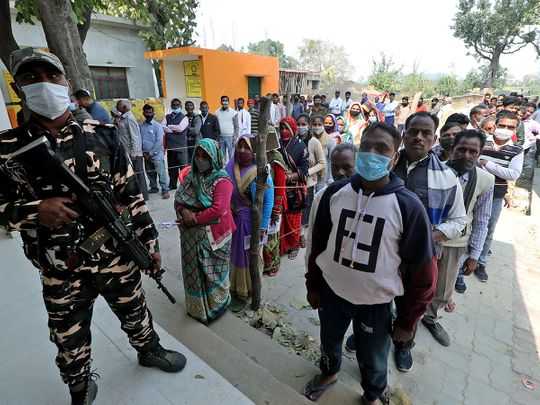
The Mahabharata, the ancient Hindu epic, is about a war between two sets of cousins, the Kauravas and the Pandavas. The Pandavas were 5 brothers. The Kauravas, one hundred brothers from the same parents.
Elections are a bit like a war between cousins. If you see the emotions that people bring to conversations about elections, if you see what’s at stake for different sets of brothers defined by caste and religion, you will agree they are not less than war.
In the Mahabharata, the Kauravas were born in Hastinapur, capital of the Kuru Kingdom. Hastinapur today is a small qasbah in Meerut district, about 3 hours westwards from Delhi. Hastinapur is also the name of one of the 403 assembly constituencies in Uttar Pradesh. It voted in the first of seven phases this election.
Bellwether Hastinapur
Hastinapur is also a bit of a bellwether: whichever party wins Hastinapur tends to also win Uttar Pradesh. After hearing that Hastinapur’s contest has become ‘too close to call’, I decided to visit the seat. Could this historic place be useful in reading the tea leaves?
Last time, in 2017, the BJP won this seat by a huge margin. The BJP candidate, Dinesh Khatik, polled 45% votes. The runner up, the Bahujan Samaj Party’s Yogesh Verma, won 29% votes. The Samajwadi Party’s Prabhu Dayal Balmiki won 23%. Around 3% votes were won by the Jat-led Rashtriya Lok Dal’s Kusum, mostly the votes of the Jat community which has a small presence here.
This is a “reserved” constituency for Dalits. The percentages tell you the non-BJP vote was quite evenly split between the Dalit-led BSP and the Samajwadi Party. The SP benefited from the presence of a large number of Muslim voters.
Mayawati’s loss is Samajwadi’s gain
So what has changed this time to make it a close contest?
The biggest change is that Yogesh Verma of the BSP has switched over to the Samajwadi Party. He belongs to the largest Dalit sub-caste, Jatavs, and is the only Jatav among the major candidates. More importantly, he is such a popular leader with Jatavs that even when he contested the seat in 2012 from a little known party, he won 21% votes. His popularity is on account of regular agitational politics, fighting for the rights of Dalits.
Among the many oddities of the Mayawati-led Bahujan Samaj Party is that it does not indulge in agitational politics. Yogesh Verma and his wife Sunita Verma, mayor of Meerut, were sacked by Mayawati in 2019 because they refused to give up agitational politics and regularly took to protesting. Yogesh Verma thereafter joined the Samajwadi Party.
No confusion
Last time, in 2017, the Samajwadi Party had a poor candidate from the Balmiki sub-caste. Getting the best possible candidate is helping them. The decline of the Bahujan Samaj Party thins election is so steep that this election is widely being seen as bi-polar. The bi-polarity has removed the usual confusion in the minds of Muslim voters whether it is the SP or the BSP they should vote for. This time, we are seeing a consolidation of Muslim votes for the Samajwadi Party. The rise in Hindutva politics has also made it incumbent upon Muslims that they should vote one way, and in a bi-polar election everyone knows which way that is.
Are the stars aligning for SP?
Remember that 3% votes the Jat-led RLD won last time? Well, this time the RLD is in alliance with the Samajwadi Party and that should help the SP too.
Beyond caste and religion, the SP also benefits somewhat by [from] some disenchantment with the BJP government on account of economic issues. For example, we met government employees from the Balmiki community who were unhappy with changes to the pension system.
That’s a lot of reasons why the SP should be winning this seat: unpopular incumbent MLA; having the best possible candidate against him; decline in the BSP’s standing before voters at large; consolidation of Muslim votes; addition of Jat votes; economic distress and general ‘anti-incumbency’ against the BJP. If this is true of Hastinapur, it is also true of Uttar Pradesh at large.
Politics is not statistics
Yet, there’s many a slip ‘twixt the cup and the lip. This writer went around Hastinapur for a day talking to voters of different communities. The biggest bad news is that the Dalit vote, including the Jatav vote, is actually split three ways.
There are Jatavs still loyal to their own party, the BSP, led by a Jatav herself. There are Jatavs voting for the Yadav-led Samajwadi Party for the first time thanks to Yogesh Verma. And then there are Jatavs voting for the BJP because of four reasons: Yogi, Modi, free ration and Hindutva.
There were Jats who were voting for the BJP despite the RLD alliance, because ‘Yogi is OK’. If the seat had an RLD candidate they would have voted for one. The general sentiment among voters of many numerically small communities in the constituency was for BJP on account of Modi, Yogi, Hindutva, free ration, law and order, and so on.
There’s a large population of Gujjars in the constituency, who, some allege, are unhappy with the BJP’s Dinesh Khatik who took sides in local disputes and rubbed many the wrong way. But this writer met Gujjars who were voting despite Khatik.
Adding up the decimals
A journalist in Meerut gives me the estimated demographic break up of the seat. It is easy to count the big numbers and say that Jatavs plus Muslims is a lot of votes here. Such calculations ignore the smaller numbers. They are Sainis and Prajapatis, Tyagis and Goswamis and so on.
Driving along the highway in Hastinapur, we saw a row of sculptors making idols of Hindu deities and historical icons. Ambedkar statues in the making coexist with Hindu deities and military figures. Large horses await the sculptor’s attention to put the rider atop them.
There are busts of commoners whose loved ones want to remember them like they’re still around. Worlds that otherwise seem apart come together in the statue maker’s workshop — a bit like the Indian election, where small communities and big all have one vote per person.
The statue makers are children of Bengalis who migrated here long ago, and who identify themselves as just ‘Bengali’. These are voters who don’t figure even in the detailed demographic break-ups that you will get from the local journalist. I asked them who they voted for, and they said BJP in a tone that said ‘Isn’t it obvious?’
Hastinapur tells you the SP has come a long way from 2017, but still has a long way to go in being able to create a ‘hawa’, a general sense that the SP is winning the hearts and minds of the floating voter to bring about a change of government.













